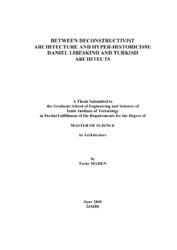Please use this identifier to cite or link to this item:
https://hdl.handle.net/11147/3880Full metadata record
| DC Field | Value | Language |
|---|---|---|
| dc.contributor.advisor | Şengel, Deniz | - |
| dc.contributor.author | Maden, Feray | - |
| dc.date.accessioned | 2014-07-22T13:52:33Z | - |
| dc.date.available | 2014-07-22T13:52:33Z | - |
| dc.date.issued | 2008 | - |
| dc.identifier.uri | http://hdl.handle.net/11147/3880 | - |
| dc.description | Thesis (Master)--İzmir Institute of Technology, Architecture, İzmir, 2008 | en_US |
| dc.description | Includes bibliographical references (leaves: 252-284) | en_US |
| dc.description | Text in English; Abstract: Turkish and English | en_US |
| dc.description | v., 449 leaves | en_US |
| dc.description.abstract | Having its origins in the discipline of philosophy and the work of Jacques Derrida and emerging from the architectural concerns of the late twentieth century, deconstructivism has profoundly affected architectural theory and practice. In contrast with extant analyses of deconstructivist architecture in formalistic and stylistic terms, this thesis undertakes in Part I in three chapters a survey of the pre-history of deconstruction starting with the early twentieth-century avant-garde movements, and modernism and postmodernism, demonstrating debt and difference, and describes in detail the paths by which deconstructive philosophy was assimilated into architecture, including an extensive reading of Derridean concepts and their implementation in architectural discourse.In two chapters, Part II undertakes demonstration of how and why Libeskind.s architectural design derives from a deconstructivist position and proves his difference from architects like Eisenman, Hadid, Tschumi, Koolhaas, Himmelb(l)au, and Gehry who have been classified as deconstructivist. The thesis identifies Libeskind as the paradigmatic deconstructivist architect by criteria obtained through close reading of Three Lessons, Micromegas, Chamberworks, and the Jewish Museum Berlin. He is shown to differ from his contemporaries by a design approach that attaches fundamental importance to .memory. and .history. as well as a systematically developed alternative to conventional architectural drawing.Part III, in two chapters, offers an overview of Turkish architectural history in the twentieth century in order to identify some contemporary Turkish architects as test cases for descriptive classification as deconstructivist and undertakes analysis of five architects with reference to criteria established in the Libeskindean context. | en_US |
| dc.language.iso | en | en_US |
| dc.publisher | Izmir Institute of Technology | en_US |
| dc.rights | info:eu-repo/semantics/openAccess | en_US |
| dc.subject.lcc | NA682.D43 M181 2008 | en |
| dc.subject.lcsh | Libeskind, Daniel 1946- | en |
| dc.subject.lcsh | Deconstructivism (Architecture) | en |
| dc.subject.lcsh | Architecture, modern--20th century | en |
| dc.subject.lcsh | Architects--Turkey | en |
| dc.subject.lcsh | Architecture--Turkey--History--20th century | en |
| dc.title | Between Deconstructivist Architecture and Hyper-Historicism: Daniel Libeskind and Turkish Architects | en_US |
| dc.type | Master Thesis | en_US |
| dc.institutionauthor | Maden, Feray | - |
| dc.department | Thesis (Master)--İzmir Institute of Technology, Architecture | en_US |
| dc.relation.publicationcategory | Tez | en_US |
| dc.identifier.wosquality | N/A | - |
| dc.identifier.scopusquality | N/A | - |
| item.grantfulltext | open | - |
| item.openairecristype | http://purl.org/coar/resource_type/c_18cf | - |
| item.fulltext | With Fulltext | - |
| item.cerifentitytype | Publications | - |
| item.languageiso639-1 | en | - |
| item.openairetype | Master Thesis | - |
| Appears in Collections: | Master Degree / Yüksek Lisans Tezleri | |
Files in This Item:
| File | Description | Size | Format | |
|---|---|---|---|---|
| T000701.pdf | MasterThesis | 18.43 MB | Adobe PDF |  View/Open |
CORE Recommender
Page view(s)
862
checked on Jul 7, 2025
Download(s)
2,090
checked on Jul 7, 2025
Google ScholarTM
Check
Items in GCRIS Repository are protected by copyright, with all rights reserved, unless otherwise indicated.